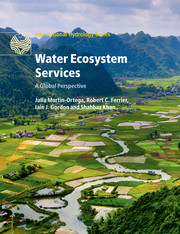Book contents
- Frontmatter
- Contents
- List of contributors
- Preface
- 1 Introduction
- 2 What defines ecosystem services-based approaches?
- Part I Addressing global challenges
- Part II Applying frameworks for water management and biodiversity conservation under an ecosystem services-based approach
- 6 Using ecosystem services-based approaches in Integrated Water Resources Management: perspectives from the developing world
- 7 Implementation of the European Water Framework Directive: what does taking an ecosystem services-based approach add?
- 8 How useful to biodiversity conservation are ecosystem services-based approaches?
- Part III Assessing water ecosystem services
- Part IV Broadening the perspective
- Index
- Plate Section
- References
7 - Implementation of the European Water Framework Directive: what does taking an ecosystem services-based approach add?
from Part II - Applying frameworks for water management and biodiversity conservation under an ecosystem services-based approach
Published online by Cambridge University Press: 05 May 2015
- Frontmatter
- Contents
- List of contributors
- Preface
- 1 Introduction
- 2 What defines ecosystem services-based approaches?
- Part I Addressing global challenges
- Part II Applying frameworks for water management and biodiversity conservation under an ecosystem services-based approach
- 6 Using ecosystem services-based approaches in Integrated Water Resources Management: perspectives from the developing world
- 7 Implementation of the European Water Framework Directive: what does taking an ecosystem services-based approach add?
- 8 How useful to biodiversity conservation are ecosystem services-based approaches?
- Part III Assessing water ecosystem services
- Part IV Broadening the perspective
- Index
- Plate Section
- References
Summary
7.1 INTRODUCTION
The European Water Framework Directive (2000) provided a step-change in the way European waters are characterised, monitored, and managed. The Directive provides a framework to integrate multiple water environments and to coordinate a range of water-relevant legislation, while advocating for public participation and economic efficiency in water management. However, in the decade since the publication of the Directive, implementation has been problematic. As the Directive moves into its second implementation cycle, the European Commission and the member states are beginning to consider how it could be delivered using the concept of ecosystem services (Martin-Ortega 2012). Therefore, this chapter considers what an ecosystem services-based approach might add to the different stages required as part of the River Basin Management Planning process in Europe, and whether the approach might improve the implementation of the Water Framework Directive.
7.1 THE WATER FRAMEWORK DIRECTIVE
7.2.1 Purpose
The objectives of the Water Framework Directive are to stop deterioration, improve the state of aquatic ecosystems, and promote the sustainable use of water by achieving ‘good ecological status’ in defined river basins (Box 7.1 collects the seven facts upon which the European Commission justifies and underpins the implementation of the Water Framework Directive). Under this norm, good ecological status is a composite assessment that measures the current state against the ‘reference condition’ for that type of water body (essentially, the state of the ecosystem before the impact of human pressures). Where the water body is at less than good status, measures (actions) must be taken. To achieve the good ecological status, cost-effective Programmes of Measures need to be set up. Where this is technically unfeasible or economically disproportionate then the objective can be reduced to moderate status or deferred to a later cycle (2021, 2027). Thus the plans provide an overview of the state of the ecosystem, the pressures on the ecosystem, and the actions that will be taken to remove the pressures and mitigate their impacts in an economically efficient way.
- Type
- Chapter
- Information
- Water Ecosystem ServicesA Global Perspective, pp. 57 - 64Publisher: Cambridge University PressPrint publication year: 2015
References
- 5
- Cited by

